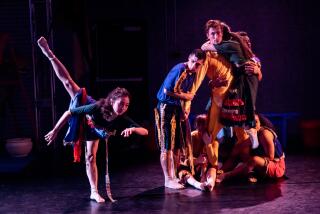Virtuosity, full speed ahead
- Share via
In 1999 and 2001, Ronald K. Brown choreographed suites for the Alvin Ailey American Dance Theater full of high moral purpose and a complex fusion of dance idioms. It was no surprise, then, to find such values dominating a four-part program by his own company at the Cerritos Center on Saturday.
If anything, the eight dancers in Ronald K. Brown/Evidence outclassed their Ailey counterparts in the ability to superimpose complex, polyrhythmic torso movement derived from African dance on legwork from the ballet/modern dance tradition. A superb Evidence member such as Diedre Dawkins, Arcell Cabuag or Brown himself could embody with each step all the cultural facets that form African American identity.
However, Evidence evidently doesn’t believe in slowness. Except for the brief, occasional use of exaggerated slow motion, or stillness, as punctuation or a special effect, Brown’s Cerritos repertory prioritized sustained, high-speed attacks, and the unyielding result could become a blur. Moreover, Brown frequently strained to approximate the kind of sophisticated, intensely personal dance-theater that European choreographers have been exploring for decades.
In his elegiac solo “For You” (2003), he continually burst out of clenched, mournful immobility or simple walking into propulsive swirls and stag-leaps. But like so much of what Brown presented Saturday, the dramatics proved rudimentary and the contrasts never went anywhere.
Excerpted from a full-evening work, the two sections of “Upside Down” (1998) featured superbly executed group undulations and a funeral procession, seen twice, for Cabuag in the role of an anguished, virtuosic outsider. The overlapping showpiece passages here defined a sense of physical freedom and unlimited energy passed from body to body.
“High Life” (2000) intercut Africanist abstractions with sections attempting social portraiture -- slinky ladies in evening gowns, workers in street clothes, old biddies with weak backs, etc. -- linked by a sense of passage depicted through the use of suitcases moved from place to place. A slave-market opening and a finale recalling it framed the work as a study of Africans in the New World, but Brown’s use of broad character stereotypes made the content of “High Life” far less compelling than its bravura performances.
A tribute to singer Nina Simone and to the freedom fighters that she celebrated in the work’s title song, “Come Ye” (2003), artfully juxtaposed layers of group motion and provided abundant solo opportunities for the Evidence paragons -- with Shani Collins memorably feisty throughout. But Brown reused too many strategies seen earlier on the program: the black-power stances, the sight of dancers dropping out of a sequence to become onlookers or witnesses, and the strategy of turning a solo into a duet into a trio by beginning a section with one dancer and then having others emerge from the wings.
No matter how superbly danced, the choreography quickly grew predictable, and interest shifted to Robert Penn’s video backdrop: images of oppression and those who triumphed over it (Muhammad Ali, Martin Luther King Jr., Gandhi). An always entertaining and purposeful program but one distinguished for its movement style rather than any originality of expression.
Besides the dancers previously mentioned, the company included Camille Brown, Bridget Moore, Juel Lane and Keon Thoulouis.
More to Read
The biggest entertainment stories
Get our big stories about Hollywood, film, television, music, arts, culture and more right in your inbox as soon as they publish.
You may occasionally receive promotional content from the Los Angeles Times.










